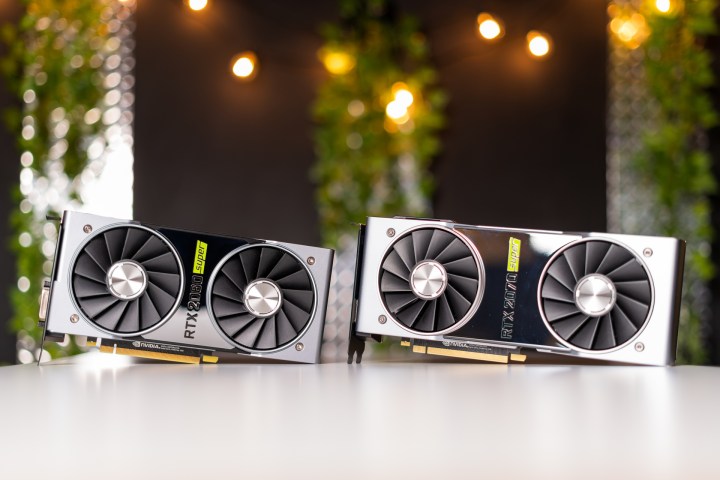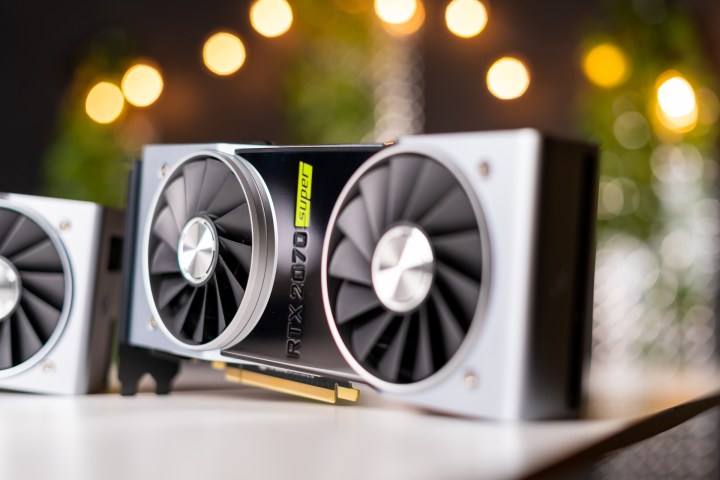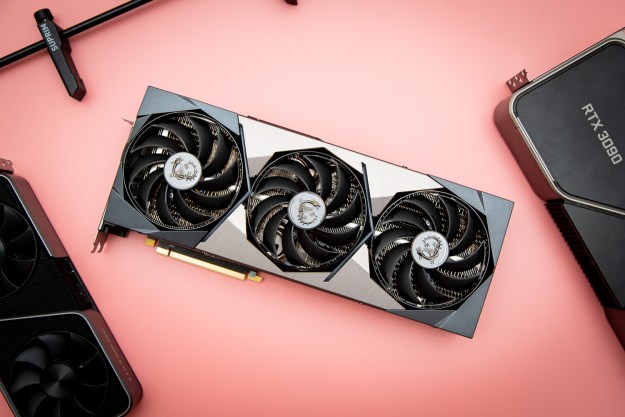
Nvidia knows what it’s doing. It knows exactly what it’s doing.
The RTX 20-series cards launched less than a year ago, but today, we have three new RTX cards to replace them. That seems a bit strange, as RTX was the debut of a new graphics architecture and a new direction for real-time ray tracing. I’d normally expect new flagship cards to remain in that position for more than a year.
Nvidia’s new release is well timed, however. AMD is gearing up to launch its own new line of graphics cards, the RX 5700 and 5700 XT. Though we don’t know exactly how those will perform, one thing’s for sure. Team Green isn’t about to let AMD have its moment in the spotlight.
What’s so super about RTX Super?
The RTX 2060 Super and 2070 Super look nearly identical to the non-Super versions. Build quality is still off the charts with an aluminum shroud and dual-fan cooling. The only notable difference is a new reflective, almost glass-like surface between the two fans atop the card. It’s an interesting choice, though I have to admit I favor the simpler aesthetic of the standard RTX series.
As the green “Super” logo indicates, there’s something special going on with both these new GPUs. Essentially, Nvidia is moving each GPU up in its product stack. The RTX 2070 Super replaces the RTX 2080, and the RTX 2060 Super replaces the RTX 2070. The RT 2080 Super is coming later this month, but Nvidia claims it sits right between the RTX 2080 and 2080 Ti.
Why is all this rearranging important? Well, it’s all a cost savings to you. Graphics cards have grown considerably in price over the past few years, and sometimes the real-life performance gain on games you play isn’t as great as you’d hope. These Super cards change that by delivering a better value every way you can slice it. Here’s how the new lineup breaks down.
| RTX 2080 Ti | RTX 2080 Super | RTX 2080 | RTX 2070 Super | RTX 2070 | RTX 2060 Super | RTX 2060 | |
| GPU | TU102 | TU104 | TU104 | TU104 | TU106 | TU106 | TU106 |
| CUDA cores | 4,352 | 3,072 | 2,944 | 2.560 | 2,304 | 2,176 | 1,920 |
| Tensor cores | 544 | 384 | 368 | 320 | 288 | 272 | 240 |
| RT Cores | 68 | 48 | 46 | 40 | 36 | 34 | 30 |
| Base clock | 1,350MHz | 1,650MHz | 1,515MHz | 1,605MHz | 1,410MHz | 1,470MHz | 1,365Mhz |
| Boost clock | 1,545MHz | 1,815MHz | 1,710Mhz | 1,770MHz | 1,620MHz | 1,650MHz | 1,680MHz |
| Memory | 11GB GDDR6 | 8GB GDDR6 | 8GB GDDR6 | 8GB GDDR6 | 8GB GDDR6 | 8GB GDDR6 | 6GB GDDR6 |
| Memory speed | 14 Gbps | 15.5Gbps | 14Gbps | 14Gbps | 14Gbps | 14Gbps | 14Gbps |
| Bandwidth | 616 GBps | 496GBps | 448GBps | 448GBps | 448GBps | 448GBps | 336GBps |
| TDP | 250w | 250w | 215w | 215w | 175w | 175w | 160w |
CUDA cores have been boosted across both cards, by 10% for the RTX 2070 Super and 12% for the 2060 Super. The 2070 Super, though, gains a larger increase in clock speed, bumping up 12% from the standard RTX 2070. The 6% boost in clock speed to the RTX 2060 Super might not seem like much, but it also gains 2GB of GDDR6 RAM and 15 watts of power. That brings memory bandwidth up to speed with the rest of the RTX lineup. For that alone, it’s worth the $50 bump over the RTX 2060.
Compared to Nvidia’s competition, the forthcoming Radeon RX 5700 XT has 2,560 cores, exactly matching the new RTX 2070 Super. The RX 5700 has more cores than even the new RTX 2060 Super, at 2,304, and nearly identical clock speeds. Again, Nvidia knew exactly what it was after with these cards.
How fast are they?
While we can’t yet compare the new Super cards against their intended competitors, we can compare them to other rivals, such as the Radeon VII and and Vega 64. These two AMD cards represent a range of the company’s lineup in terms of price and performance. We tested all these cards in a test rig sporting a Core i7-8086K, 16GB of G.Skill DDR4 RAM, and a Samsung 950Pro M.2 SSD.
As we always do, we started with 3DMark’s Time Spy benchmark, a DX12 test that represents a large swath of the modern PC games you play today. The results weigh heavily in Nvidia’s favor.
As you can see, the RTX 2070 Super doesn’t match the RTX 2080, but it’s not far behind. We didn’t have an RTX 2070 on hand, but you can see how much ground the 2070 Super has made on the 2080. That’s impressive.
The RTX 2060 Super lands 11% behind the 2070 Super, but more importantly, it squeaks ahead of the Radeon VII. This is bad news for AMD, because Nvidia’s card is $300 less expensive.
The situation looks even worse for AMD’s older flagship, the Vega 64. The late 2017 release originally launched at $499, and squares up poorly against the cheaper RTX 2060 Super.
Benchmarks don’t tell the whole story, though. We also took the Super cards through our typical suite of test games, which include Fortnite, Battlefield V, Civilization VI, and Assassin’s Creed Odyssey. Again, Nvidia has come out with its all-stars and puts the ball squarely in AMD’s court.
In Fortnite at 1080p at Epic settings, The RTX 2060 Super puts the Radeon VII to shame. As in Time Spy, the $699 card is a few frames behind the more affordable RTX 2060 Super. The 2070 Super, meanwhile, spit out a speedy 172 FPS. That’s plenty for that high refresh monitor you might have. Even at 4K Epic, the 2070 Super averages over 60 FPS. That kind of 4K capability in a fast-paced game like Fortnite was previously limited to cards over $699.
Civilization VI is more CPU-heavy game than some of the others, which explains why the difference between these cards at 1080p isn’t all that noticeable. However, when you move to 1440p or 4K, you again see the raw strength of the RTX 2070 Super. The game blistered along at an average of 96 FPS in
We always test cards with Assassin’s Creed Odyssey, a game that provides a seriously demanding workload on graphics cards. At lower settings, anywhere from 1080p High to 1440p High, the RTX 2060 Super beats the Radeon VII by a few FPS. From 1440p Ultra High on up to 4K, the Radeon VII takes back that lead, but never quite enough to catch the RTX 2070 Super. In this game in particular, the 2070 Super is neck-and-neck with the 2080, which is again an impressive achievement. Though none of these cards can play Odyssey at

Battlefield V is the primary outlier in our results. All the Nvidia cards lag behind in this game, and that includes the RTX 2080. The Radeon VII happily leads the pack, even beating the expensive RTX 2080 in most graphic detail settings and high resolutions. Neither of the Super cards can capture 60 FPS at 4K, which is a bit disappointing.
Despite the hiccup in Battlefield V, these two Super cards are serious rock stars, and add tremendous value to already powerful GPUs.
The larger war looms
If you’ve been holding off a purchase until you heard more about these Super cards, your patience will be rewarded. With significant performance improvements at hardly any cost increase. In many ways, they feel like the cards that should have launched a year ago. The RTX 2070 Super is still priced well beyond what the average gamer can afford, but even it makes a better case for the strength of the Turing architecture than ever before.
The Super cards win Nvidia the battle, but the real war is ahead. AMD’s RX 5000-series GPUs land just next week, and when they do, they’ll have tough competition from Nvidia. Who will win? Check back soon to find out.
Editors' Recommendations
- The war between PC and console is about to heat up again
- Intel may fire the first shots in the next-gen GPU war
- The RTX 5090 and 5080 may launch sooner than expected
- The sad reality of AMD’s next-gen GPUs comes into view
- Everything you need to know about buying a GPU in 2024







